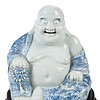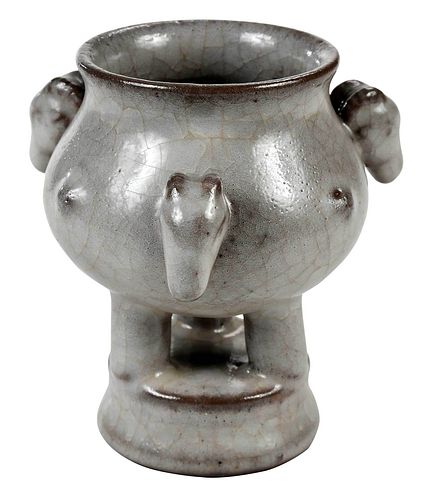Chinese Yue Style Horse Head Incense Burner
Bid Increments
| Price | Bid Increment |
|---|---|
| $0 | $25 |
| $100 | $50 |
| $1,000 | $100 |
| $2,000 | $200 |
| $3,000 | $250 |
| $5,000 | $500 |
| $10,000 | $1,000 |
| $20,000 | $2,000 |
| $50,000 | $5,000 |
| $100,000 | $10,000 |
gray glaze thinning to darker brown on high relief areas and rim, three horse head handles, three short legs supported by a round base, 5-1/2 x 5-1/4 in.
Note: Longquan celadon (????) is a type of green-glazed Chinese ceramic, known in the West as celadon or greenware, produced from about 950 to 1550. Longquan celadons were an important part of China's export economy for over five hundred years, and were widely imitated in other countries, especially Korea and Japan. The Longquan celadons were among the finest of a range of celadon wares produced in China, and led stylistic and technical developments. The celadons were produced in a range of shades of color, centered on olive-green, but extending to greenish blues (regarded as desirable, but less common) and browns. As for the horse head mottled figures, horses have a very high status in traditional Chinese culture. The traditional Chinese character of the word horse (?) looks like a standing horse. In ancient China, there were six main kinds of domestic animals: horse, cattle, sheep, chicken, dog, and pig. The horse was the most important one. It represents the image of courage, integrity, diligence and power. In addition to its contribution to transportation, horse was also an important part of the military force. (wiki)
Provenance: Private Collection, ColoradoCondition
crazing, pin holes in glaze due to firing anomalies, minute chips to underside of foot
Purchased items will be available for pick up or shipping from our Asheville, North Carolina auction facility within ten business days of the auction will be assessed a storage fee of $5.00 per day, per item. Purchaser agrees that packing and shipping is done at the purchaser's risk and that the purchaser will pay in advance all packing expenses, materials, carrier fees and insurance charges. At our discretion, items will either be packed by an agent such as a packaging store or Brunk Auctions. Please allow two weeks for shipping after payment is received. Shipment of large items is the responsibility of the purchaser. We are happy to provide names of carriers and shippers if a purchaser so requests. Brunk Auctions will have no liability for any loss or damage to shipped items.













